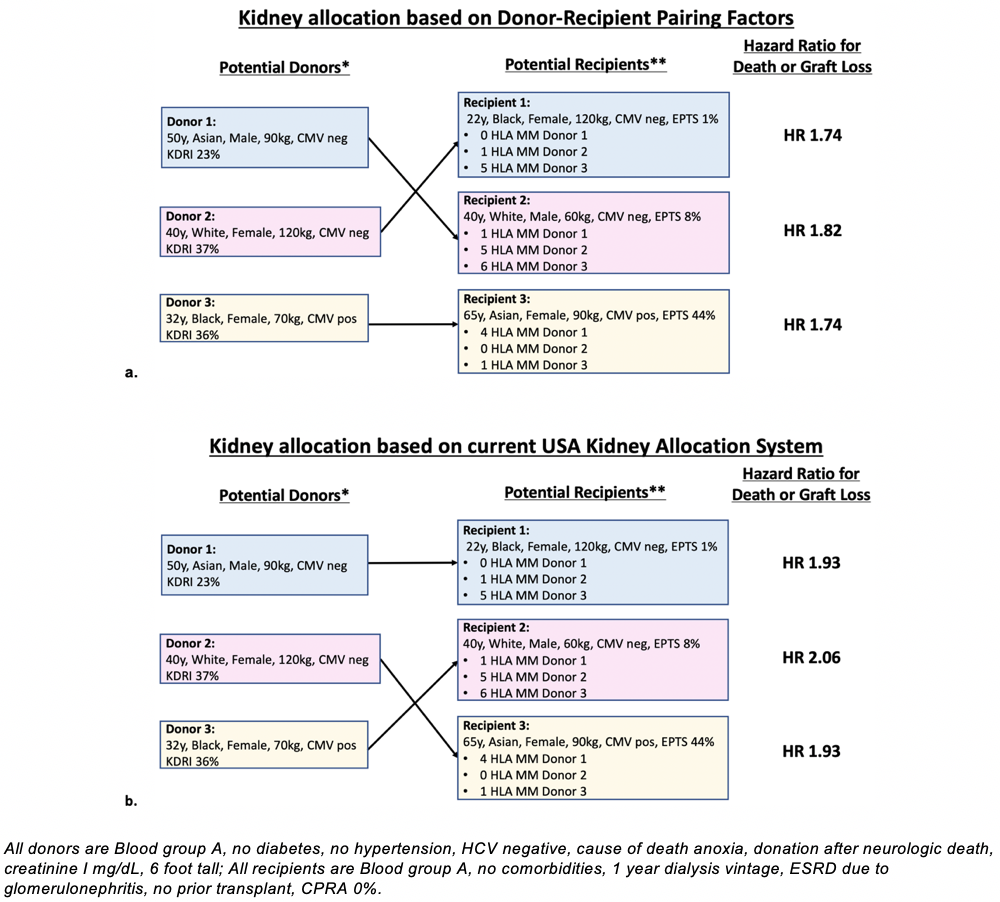Donor-Recipient Matching in Kidney Transplant: The Whole is Greater Than the Sum of the Parts
Dalhousie University, Halifax, NS, Canada
Meeting: 2019 American Transplant Congress
Abstract number: A218
Keywords: Allocation, Graft failure, Kidney, Multivariate analysis
Session Information
Session Name: Poster Session A: Kidney Deceased Donor Allocation
Session Type: Poster Session
Date: Saturday, June 1, 2019
Session Time: 5:30pm-7:30pm
 Presentation Time: 5:30pm-7:30pm
Presentation Time: 5:30pm-7:30pm
Location: Hall C & D
*Purpose: In deceased donor kidney transplantation, strategic organ allocation is expected to prolong patient and graft survival after transplant. The aim of this study was to determine if strategic pairing of kidney donors and recipients (D-R) based on immunologic and non-immunologic factors leads to better patient/graft survival than expected using the current United States Kidney Allocation System (KAS).
*Methods: A multivariable Cox proportional Hazard’s model was used to assess the association of D-R factors (including pairing variables) with the composite outcome of death or kidney graft loss using data from adult recipients identified using the Scientific Registry of Transplant recipients from 2000-2014. The overall hazard ratio for the outcome of interest was determined for three hypothetical donor kidneys transplanted into each of three hypothetical recipients, relative to an ideally matched D-R pairing. Median survival for each of the nine possible D-R pairing combinations was determined relative to that for an ideally matched D-R pair. Outcomes for strategic D-R pairing were compared to outcomes obtained using the KAS to allocate the three theoretical donor kidneys amongst the three available recipients. The difference in months of median patient/graft survival between the two allocation strategies was determined.
*Results: 31,607 patients developed death or graft loss amongst a total of 106,593 patients included in the analysis. Median survival for ideal D-R pairings was 10.31 years (Q1 4.31, Q3 14.32). Relative to the lowest risk D-R pairing, strategic allocation of kidneys resulted in HRs for death or graft loss of 1.74 (95% CI 1.41-2.14), 1.82 (95% CI 1.46-2.26) and 1.74 (95% CI 1.38-2.19) for recipients 1, 2, and 3 respectively whereas by following the current KAS, HRs for death or graft loss were 1.93 (95% CI 1.63-2.28), 2.06 (95% CI 1.74-2.44) and 1.93 (95% CI 1.58-2.37). This corresponds to 3.84, 11.39 and 7.40 months longer patient or graft survival for recipients 1, 2 and 3, respectively if kidneys are allocated using strategic D-R pairing instead of the KAS.
*Conclusions: Allocation of kidneys by strategic D-R pairing may result in improved patient/graft survival compared with allocation of kidneys by the current KAS. However, the equity of allocating organs in this manner deserves further study.
To cite this abstract in AMA style:
Vinson A, Tennankore K, Kiberd B. Donor-Recipient Matching in Kidney Transplant: The Whole is Greater Than the Sum of the Parts [abstract]. Am J Transplant. 2019; 19 (suppl 3). https://atcmeetingabstracts.com/abstract/donor-recipient-matching-in-kidney-transplant-the-whole-is-greater-than-the-sum-of-the-parts/. Accessed December 16, 2025.« Back to 2019 American Transplant Congress

